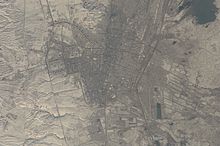Ashgabat
|
Areas Page Editors: please follow the Guidelines, whether you are editing an in-game area or World Territory. |
On this page... (hide)
- 1. Description
- 2. Culture
- 3. Significance
- 4. References
Territory Statistics
| Status | OPEN ? |
| Alternate Text | Aşgabat, Ашгабат, Ашхабад, Poltorask, Ešq-ābād, عشقآباد, Ashkhabad |
| Name Meaning | "City of love", "city of devotion", or "the city of Ashk/Arsaces" |
| Name Origin | Turkmen |
| Date of Founding | 1881 |
| Primary Species | WIP |
| Luperci Dominant | No |
| Population | ~50 |
| Religion | -- |
Ashgabat (Turkmen: Aşgabat, pronounced [ɑʃʁɑˈbɑt̪]; Russian: Ашхабад, tr. Ashkhabad, IPA: [ɐʂxɐˈbat]) — named Poltoratsk (Russian: Полтора́цк, IPA: [pəltɐˈrat͡sk]) between 1919 and 1927, was the capital and the largest city of Turkmenistan in Central Asia, situated between the Karakum Desert and the Kopet Dag mountain range.
The city was founded in 1881, and made the capital of the Turkmen Soviet Socialist Republic in 1924. Much of the city was destroyed by the 1948 Ashgabat earthquake. The Karakum Canal runs through the city, carrying waters from the Amu Darya from east to west. It has the highest concentration of white marble buildings in the world, though some have undoubtedly fallen or been damaged without human intervention.
1. Description
Ashgabat is a relatively young city, having been founded in 1881 as a fortification and named after the nearby settlement of Askhabad (lit. beloved city in Turkmen). Located not far from the site of Nisa, the ancient capital of the Parthian Empire, it grew on the ruins of the Silk Road city of Konjikala, first mentioned as a wine-producing village in the 2nd century BC and leveled by an earthquake in the 1st century BC (a precursor of the 1948 Ashgabat earthquake). Konjikala was rebuilt because of its advantageous location on the Silk Road and it flourished until its destruction by Mongols in the 13th century. After that it survived as a small village until Russians took over in the 19th century.
A part of Persia until the Battle of Geok Tepe, Askhabad was ceded to the Russian Empire under the terms of the Akhal Treaty. Russia developed the area as it was close to the border of British-influenced Persia, and the population grew from 2,500 in 1881 to 19,428 (of whom one third were Persian) in 1897. It was regarded as a pleasant town with European style buildings, shops, and hotels. In 1908, the first Bahá'í House of Worship was built in Askhabat. It was badly damaged in the 1948 earthquake and finally demolished in 1963.[9] The community of the Bahá'í Faith in Turkmenistan was largely based in Ashgabat.
Soviet rule was established in Ashgabat in December 1917. However, in July 1918, a coalition of Mensheviks, Social Revolutionaries, and Tsarist former officers of the Imperial Russian Army revolted against the Bolshevik rule emanating from Tashkent and established the Ashkhabad Executive Committee. After receiving some support (but even more promises) from General Malleson, the British withdrew in April 1919 and the Tashkent Soviet resumed control of the city.
In 1919, the city was renamed Poltoratsk (Полторацк), after Pavel Poltoratsky, the Chairman of the Soviet of National Economy of the Turkestan Autonomous Soviet Socialist Republic. When the Turkmen SSR was established in 1924, Poltoratsk became its capital. The original name (in the form of "Ashkhabad") was restored in 1927. From this period onward, the city experienced rapid growth and industrialisation, although severely disrupted by a major earthquake on October 6, 1948. An estimated 7.3 on the Richter scale, the earthquake killed 110-176,000 (⅔ of the population of the city), although the official number announced by Soviet news was only 40,000.
The Kopet-Dag mountain range is about 25 kilometres (16 mi) to the south, and Ashgabat's northern boundary touches the Kara-Kum desert. Because of this Ashgabat has an arid climate with hot, dry summers and cool, short winters. The average high temperature in July is 38.3 °C (100.9 °F). Nighttimes in the summer are warm, with an average minimum temperature in July of 23.8 °C (75 °F). The average January high temperature is 8.6 °C (47.5 °F), and the average low temperature is −0.4 °C (31.3 °F). The highest temperature ever recorded in Ashgabat is 47.2 °C (117 °F), recorded in June 2015.[40] A low temperature of −24.1 °C (−11 °F) was recorded in January 1969. Snow is infrequent in the area. Annual precipitation is only 201 millimetres (7.91 in); March and April are the wettest months, and summer drought, from late June to September, is virtually absolute.
2. Culture
:D
3. Significance
:D
4. References
- Ashgabat at Wikipedia (Text has been sourced from here)

